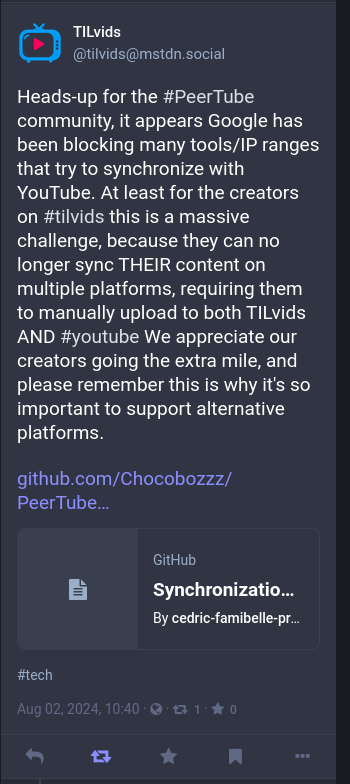915
you are viewing a single comment's thread
view the rest of the comments
view the rest of the comments
this post was submitted on 17 Sep 2024
915 points (99.7% liked)
Technology
59174 readers
1654 users here now
This is a most excellent place for technology news and articles.
Our Rules
- Follow the lemmy.world rules.
- Only tech related content.
- Be excellent to each another!
- Mod approved content bots can post up to 10 articles per day.
- Threads asking for personal tech support may be deleted.
- Politics threads may be removed.
- No memes allowed as posts, OK to post as comments.
- Only approved bots from the list below, to ask if your bot can be added please contact us.
- Check for duplicates before posting, duplicates may be removed
Approved Bots
founded 1 year ago
MODERATORS

It still lasts because there's no easy way YT can offer their own content without the video being available as a file stream (through CDNs at googlevideos subdomains). If they centralize everything to a single, controlled domain (so to allow things as one-time HTTPS request, better session checking and so on), they'd lost the capability of load balancing allowed by the decentralized nature of CDNs. YouTube downloaders (and, by extension, third-party YT frontends such as Invidious) exploit this CDN aspect to download the videos.
It's common to see Invidious instances momentarily blocked. The blockage can't last forever for two reasons: firstly, IPs (especially IPv4) changes due to how ISPs offer IPv4 addresses through CGNAT, so the instance IPv4 (generally domestic servers) will eventually change (often to a completely different IPv4 range) and YouTube won't know that the new IP is a former "offender". Secondly, as IPv4s works through CGNAT, Google can't keep the bans forever because this IPv4 will be eventually rotated to another client from ISP that's completely unrelated and unaware of how their IPv4 was a former address for a downloader. It's like how Signal/WhatsApp/Telegram/Facebook/phone-required services can't really keep a permanent ban for a specific prepaid number (especially on countries like Brazil, where ANATEL allows for phone number rotation when the mobile plan is cancelled), because the number will be potentially owned by another person with nothing to do with the former owner.
So, in summary, Google can either end with YouTube CDNs (ditching their load balancing), or they can try to implement an innovative way to keep load balancing while serving the request one-time only, or they won't be able to do nothing but to perpetually catch themselves drying ice cubes.
Maybe a stupid question, but how do paid streaming services avoid that issue?
Not the OP, and I don't actually know, but paid streaming services differ from YouTube in that everyone who accesses the content is paying for the service. On one hand, you can validate that everytime a video is served, it's served to a paying user. On the other, you are receiving revenue directly from consumers to fund the infrastructure to store and serve the videos.
YouTube, on the other hand, stores significantly more content, for free, and can be accessed for free, without being signed in.